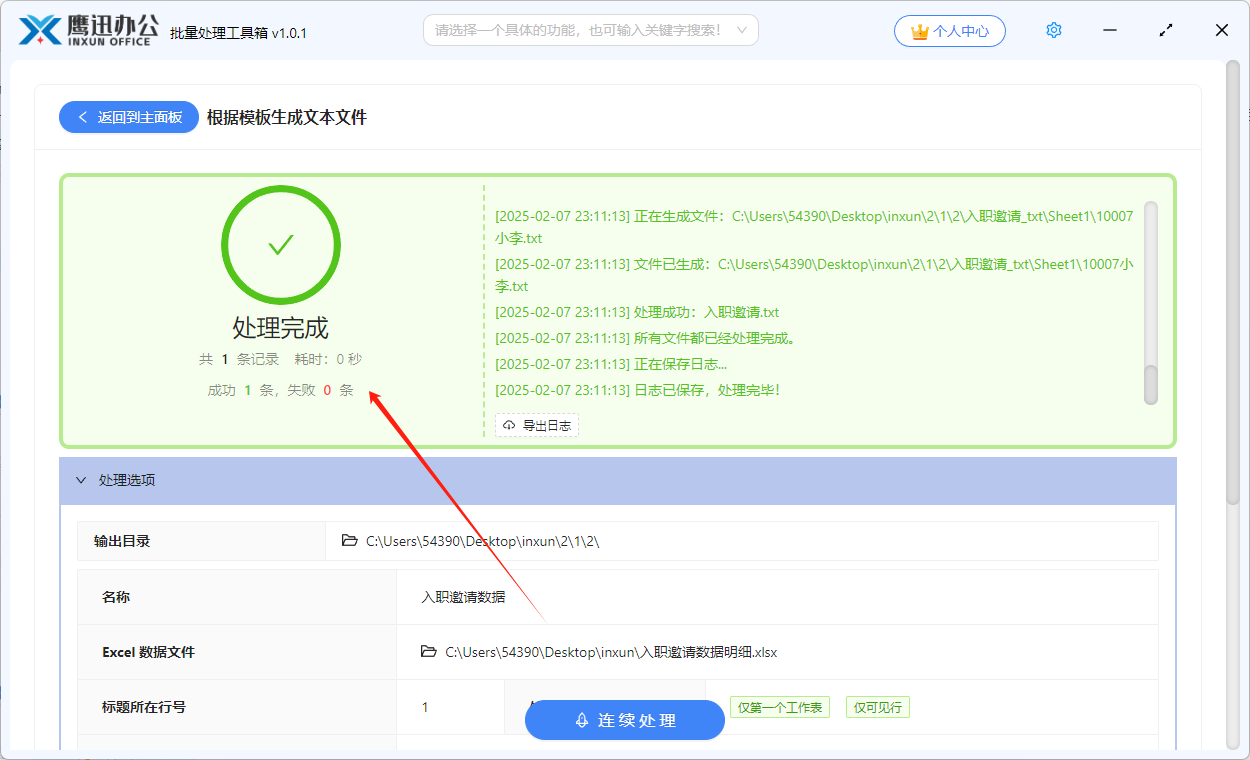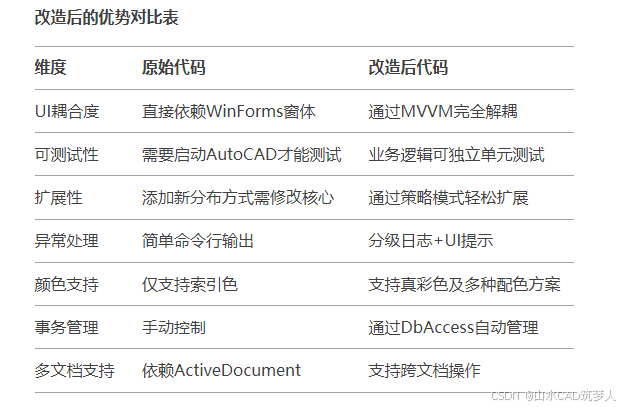官方文档位置: Visualization - Open3D 0.19.0 documentation![]() https://www.open3d.org/docs/release/tutorial/visualization/visualization.html核心方法:
https://www.open3d.org/docs/release/tutorial/visualization/visualization.html核心方法:
o3d.visualization.draw_geometries([几何对象列表])
import open3d as o3d
print("Load a ply point cloud, print it, and render it")
sample_ply_data = o3d.data.PLYPointCloud()
pcd = o3d.io.read_point_cloud(sample_ply_data.path)
o3d.visualization.draw_geometries([pcd],
zoom=0.3412,
front=[0.4257, -0.2125, -0.8795],
lookat=[2.6172, 2.0475, 1.532],
up=[-0.0694, -0.9768, 0.2024])
visualization窗体功能:
点击到窗口 按键盘 h 键

(1) 视图控制
| 操作 | 方法 |
|---|---|
| 旋转视图 | 按住鼠标左键拖动 |
| 平移视图 | 按住鼠标滚轮拖动 |
| 缩放视图 | 鼠标滚轮 |
| 重置视角 | 按 R 键 |
| 切换全屏 | 按 F 键 |
| 快捷键 | 功能 |
|---|---|
L | 切换点云渲染(点/线框/面) |
N | 显示/隐藏法线(需提前计算) |
C | 显示/隐藏颜色(如果数据包含颜色) |
S | 保存当前视角截图 |
添加几何元素
下面的代码使用 、 和 生成一个长方体、一个球体和一个圆柱体。长方体涂成红色,球体涂成蓝色,圆柱体涂成绿色。为所有网格计算法线以支持 Phong 着色(请参见可视化 3D 网格和表面法线估计)。我们甚至可以使用 创建一个坐标轴,其原点设置为 (-2, -2, -2)。
import open3d as o3d
print("Let's define some primitives")
#创建立方体
mesh_box = o3d.geometry.TriangleMesh.create_box(width=1.0,
height=1.0,
depth=1.0)
#设置颜色
mesh_box.paint_uniform_color([0.9, 0.1, 0.1])
#创建球体
mesh_sphere = o3d.geometry.TriangleMesh.create_sphere(radius=1.0)
#设置颜色
mesh_sphere.paint_uniform_color([0.1, 0.1, 0.7])
#创建圆柱体
mesh_cylinder = o3d.geometry.TriangleMesh.create_cylinder(radius=0.3,
height=4.0)
mesh_cylinder.paint_uniform_color([0.1, 0.9, 0.1])
#创建坐标轴
mesh_frame = o3d.geometry.TriangleMesh.create_coordinate_frame(
size=0.6, origin=[-2, -2, -2])
print("We draw a few primitives using collection.")
o3d.visualization.draw_geometries(
[mesh_box, mesh_sphere, mesh_cylinder, mesh_frame])
print("We draw a few primitives using + operator of mesh.")
o3d.visualization.draw_geometries(
[mesh_box + mesh_sphere + mesh_cylinder + mesh_frame])
绘制线
Visualization - Open3D 0.19.0 documentation![]() https://www.open3d.org/docs/release/tutorial/visualization/visualization.html#Draw-line-set
https://www.open3d.org/docs/release/tutorial/visualization/visualization.html#Draw-line-set
import open3d as o3d
print("Let's draw a box using o3d.geometry.LineSet.")
# 点坐标
points = [
[0, 0, 0],
[1, 0, 0],
[0, 1, 0],
[1, 1, 0],
[0, 0, 1],
[1, 0, 1],
[0, 1, 1],
[1, 1, 1],
]
# 线段索引 [0, 1] 表示0号点到1号点的线段
lines = [
[0, 1],
[0, 2],
[1, 3],
[2, 3],
[4, 5],
[4, 6],
[5, 7],
[6, 7],
[0, 4],
[1, 5],
[2, 6],
[3, 7],
]
colors = [[1, 0, 0] for i in range(len(lines))]
line_set = o3d.geometry.LineSet(
points=o3d.utility.Vector3dVector(points), # 点坐标 需要转换为Vector3dVector Vector3dVector 是一个关键的数据转换工具,
# 用于将常见的数值数组(如 NumPy 数组或 Python 列表)转换为 Open3D 内部高效处理的 3D 向量格式 N×3
lines=o3d.utility.Vector2iVector(lines),
)
line_set.colors = o3d.utility.Vector3dVector(colors)
o3d.visualization.draw_geometries([line_set])
Vector2iVector 是一个用于处理 二维整数向量数据 的实用工具类,类似于 Vector3dVector,但专为 (N, 2) 形状的整数数据设计
Vector3dVector 是一个关键的数据转换工具,用于将常见的数值数组(如 NumPy 数组或 Python 列表)转换为 Open3D 内部高效处理的 3D 向量格式,主要功能:将 N×3 的数值数据(如点云坐标、法线、颜色)转换为 Open3D 几何体(如 PointCloud、TriangleMesh)可识别的内部数据结构。
自定义可视化 自定义创建功能
Customized visualization - Open3D 0.19.0 documentation![]() https://www.open3d.org/docs/release/tutorial/visualization/customized_visualization.html#customized-visualization使点云旋转
https://www.open3d.org/docs/release/tutorial/visualization/customized_visualization.html#customized-visualization使点云旋转
import open3d as o3d
def custom_draw_geometry_with_rotation(pcd):
def rotate_view(vis):
ctr = vis.get_view_control()
ctr.rotate(10.0, 0.0)
return False
o3d.visualization.draw_geometries_with_animation_callback([pcd],
rotate_view)
sample_pcd_data = o3d.data.PCDPointCloud()
pcd = o3d.io.read_point_cloud(sample_pcd_data.path)
custom_draw_geometry_with_rotation(pcd)https://www.open3d.org/docs/release/_images/rotate_small.gif
交互式可视化
Interactive visualization - Open3D 0.19.0 documentation
# examples/python/visualization/interactive_visualization.py
import numpy as np
import copy
import open3d as o3d
def demo_crop_geometry():
print("Demo for manual geometry cropping")
print(
"1) Press 'Y' twice to align geometry with negative direction of y-axis"
)
print("2) Press 'K' to lock screen and to switch to selection mode")
print("3) Drag for rectangle selection,")
print(" or use ctrl + left click for polygon selection")
print("4) Press 'C' to get a selected geometry")
print("5) Press 'S' to save the selected geometry")
print("6) Press 'F' to switch to freeview mode")
pcd_data = o3d.data.DemoICPPointClouds()
pcd = o3d.io.read_point_cloud(pcd_data.paths[0])
o3d.visualization.draw_geometries_with_editing([pcd])
def draw_registration_result(source, target, transformation):
source_temp = copy.deepcopy(source)
target_temp = copy.deepcopy(target)
source_temp.paint_uniform_color([1, 0.706, 0])
target_temp.paint_uniform_color([0, 0.651, 0.929])
source_temp.transform(transformation)
o3d.visualization.draw_geometries([source_temp, target_temp])
def prepare_data():
pcd_data = o3d.data.DemoICPPointClouds()
source = o3d.io.read_point_cloud(pcd_data.paths[0])
target = o3d.io.read_point_cloud(pcd_data.paths[2])
print("Visualization of two point clouds before manual alignment")
draw_registration_result(source, target, np.identity(4))
return source, target
def pick_points(pcd):
print("")
print(
"1) Please pick at least three correspondences using [shift + left click]"
)
print(" Press [shift + right click] to undo point picking")
print("2) After picking points, press 'Q' to close the window")
vis = o3d.visualization.VisualizerWithEditing()
vis.create_window()
vis.add_geometry(pcd)
vis.run() # user picks points
vis.destroy_window()
print("")
return vis.get_picked_points()
def register_via_correspondences(source, target, source_points, target_points):
corr = np.zeros((len(source_points), 2))
corr[:, 0] = source_points
corr[:, 1] = target_points
# estimate rough transformation using correspondences
print("Compute a rough transform using the correspondences given by user")
p2p = o3d.pipelines.registration.TransformationEstimationPointToPoint()
trans_init = p2p.compute_transformation(source, target,
o3d.utility.Vector2iVector(corr))
# point-to-point ICP for refinement
print("Perform point-to-point ICP refinement")
threshold = 0.03 # 3cm distance threshold
reg_p2p = o3d.pipelines.registration.registration_icp(
source, target, threshold, trans_init,
o3d.pipelines.registration.TransformationEstimationPointToPoint())
draw_registration_result(source, target, reg_p2p.transformation)
def demo_manual_registration():
print("Demo for manual ICP")
source, target = prepare_data()
# pick points from two point clouds and builds correspondences
source_points = pick_points(source)
target_points = pick_points(target)
assert (len(source_points) >= 3 and len(target_points) >= 3)
assert (len(source_points) == len(target_points))
register_via_correspondences(source, target, source_points, target_points)
print("")
if __name__ == "__main__":
demo_crop_geometry()
demo_manual_registration()draw_geometries_with_editing 默认绑定的功能 可以实现点云的剪切
以下是打印信息中提到的按键及其作用:
| 按键 | 功能 | 触发条件 |
|---|---|---|
| Y (按两次) | 将几何体对齐到 Y 轴负方向 | 必须在非锁定模式下 |
| K | 锁定屏幕并进入选择模式 | 任意时刻 |
| Ctrl + 左键 | 多边形选择模式 | 必须在选择模式下 |
| 拖动鼠标 | 矩形框选 | 必须在选择模式下 |
| C | 提取选中区域的几何体 | 必须在选择模式下有选中区域 |
| S | 保存当前几何体到 edited_model.ply | 任意时刻 |
| F | 退出选择模式,返回自由视角 | 必须在选择模式下 |
自定义按键绑定(高级用法)
如果需要覆盖默认行为或添加新功能,可以通过 注册回调函数 实现:
def custom_key_callback(vis):
print("Custom key pressed!")
return False
vis = o3d.visualization.VisualizerWithEditing()
vis.create_window()
vis.register_key_callback(ord("Q"), custom_key_callback) # 绑定Q键
vis.add_geometry(pcd)
vis.run()Interactive visualization - Open3D 0.19.0 documentation
实现手动选点
核心代码
def pick_points(pcd):
print("")
print(
"1) Please pick at least three correspondences using [shift + left click]"
)
print(" Press [shift + right click] to undo point picking")
print("2) After picking points, press 'Q' to close the window")
vis = o3d.visualization.VisualizerWithEditing()
vis.create_window()
vis.add_geometry(pcd)
vis.run() # user picks points
vis.destroy_window()
print("")
return vis.get_picked_points()进行点云配准
def register_via_correspondences(source, target, source_points, target_points):
"""
通过用户提供的对应点对进行点云粗配准 + ICP精配准
参数:
source (open3d.geometry.PointCloud): 待配准的源点云
target (open3d.geometry.PointCloud): 目标点云
source_points (list/np.array): 源点云中选取的对应点索引数组
target_points (list/np.array): 目标点云中对应的点索引数组
"""
# 1. 构建对应点对矩阵 (N x 2)
corr = np.zeros((len(source_points), 2)) # 初始化对应点对容器
corr[:, 0] = source_points # 第一列填充源点云索引
corr[:, 1] = target_points # 第二列填充目标点云索引
# 2. 基于对应点对计算初始变换矩阵
print("Compute a rough transform using the correspondences given by user")
# 创建点对点变换估计器
p2p = o3d.pipelines.registration.TransformationEstimationPointToPoint()
# 计算初始变换矩阵(将source_points对齐到target_points)
trans_init = p2p.compute_transformation(
source,
target,
o3d.utility.Vector2iVector(corr) # 将对应点对转换为Open3D格式
)
# 3. 使用ICP进行精细配准
print("Perform point-to-point ICP refinement")
threshold = 0.03 # 3cm距离阈值,超过此距离的点对不参与计算
reg_p2p = o3d.pipelines.registration.registration_icp(
source, # 源点云
target, # 目标点云
threshold, # 最大对应点距离阈值
trans_init, # 上一步计算的初始变换
o3d.pipelines.registration.TransformationEstimationPointToPoint(), # 使用点对点ICP
# 可选参数(未显式设置时使用默认值):
# criteria = ICP迭代停止条件(默认最大迭代30次,相对变化1e-6)
# estimation_method = 变换估计方法
)
# 4. 可视化配准结果
draw_registration_result(source, target, reg_p2p.transformation)
# 返回配准结果(包含变换矩阵、拟合度等信息)
return reg_p2p典型使用场景:
# 示例:手动选取5对对应点进行配准
source_idx = [10, 20, 30, 40, 50] # 源点云中选取的点索引
target_idx = [15, 25, 35, 45, 55] # 目标点云中对应的点索引
result = register_via_correspondences(source_pcd, target_pcd, source_idx, target_idx)
print("Final transformation matrix:\n", result.transformation)非阻塞窗口 不停止窗口 并更新窗口显示
import open3d as o3d
import numpy as np
def prepare_data():
# 加载Open3D提供的示例点云数据(两帧扫描数据)
pcd_data = o3d.data.DemoICPPointClouds()
source_raw = o3d.io.read_point_cloud(pcd_data.paths[0]) # 源点云
target_raw = o3d.io.read_point_cloud(pcd_data.paths[1]) # 目标点云
# 体素下采样(降低计算量)
source = source_raw.voxel_down_sample(voxel_size=0.02)
target = target_raw.voxel_down_sample(voxel_size=0.02)
# 对源点云施加初始变换(模拟初始位姿偏差)
trans = [[0.862, 0.011, -0.507, 0.0],
[-0.139, 0.967, -0.215, 0.7],
[0.487, 0.255, 0.835, -1.4],
[0.0, 0.0, 0.0, 1.0]] # 4x4变换矩阵
source.transform(trans)
# 对两个点云施加镜像翻转(使可视化效果更直观)
flip_transform = [[1, 0, 0, 0],
[0, -1, 0, 0],
[0, 0, -1, 0],
[0, 0, 0, 1]]
source.transform(flip_transform)
target.transform(flip_transform)
return source, target
def demo_non_blocking_visualization():
# 设置日志级别为Debug(显示详细运行信息)
o3d.utility.set_verbosity_level(o3d.utility.VerbosityLevel.Debug)
# 加载数据
source, target = prepare_data()
# 创建可视化窗口并添加几何体
vis = o3d.visualization.Visualizer()
vis.create_window()
vis.add_geometry(source) # 添加源点云(红色)
vis.add_geometry(target) # 添加目标点云(蓝色)
# ICP参数设置
threshold = 0.05 # 距离阈值(5cm内视为对应点)
icp_iteration = 100 # 总迭代次数
save_image = False # 是否保存每帧截图
# 迭代执行ICP
for i in range(icp_iteration):
# 执行单次ICP迭代(max_iteration=1表示每步只迭代一次)
reg_p2l = o3d.pipelines.registration.registration_icp(
source, target, threshold, np.identity(4),
o3d.pipelines.registration.TransformationEstimationPointToPlane(),
o3d.pipelines.registration.ICPConvergenceCriteria(max_iteration=1))
# 更新源点云位置
source.transform(reg_p2l.transformation)
# 刷新可视化
vis.update_geometry(source) # 通知可视化器几何体已更新
vis.poll_events() # 处理UI事件(如窗口缩放)
vis.update_renderer() # 重绘场景
# 可选:保存当前帧截图
if save_image:
vis.capture_screen_image("temp_%04d.jpg" % i)
# 关闭窗口
vis.destroy_window()
o3d.utility.set_verbosity_level(o3d.utility.VerbosityLevel.Info) # 恢复日志级别
if __name__ == '__main__':
demo_non_blocking_visualization()关键点:
-
非阻塞可视化三要素:
-
update_geometry():标记需要更新的几何体 -
poll_events():处理用户交互事件 -
update_renderer():触发画面重绘
-
-
ICP配置:
-
TransformationEstimationPointToPlane:使用点到面ICP(比点到点更鲁棒) -
max_iteration=1:每次外部循环只做一次ICP迭代,实现逐步可视化
-
此脚本调用每次迭代。请注意,它通过 .这是从单个 ICP 迭代中检索轻微姿势更新的技巧。在 ICP 之后,源几何体会相应地变换。registration_icpICPConvergenceCriteria(max_iteration = 1)




















